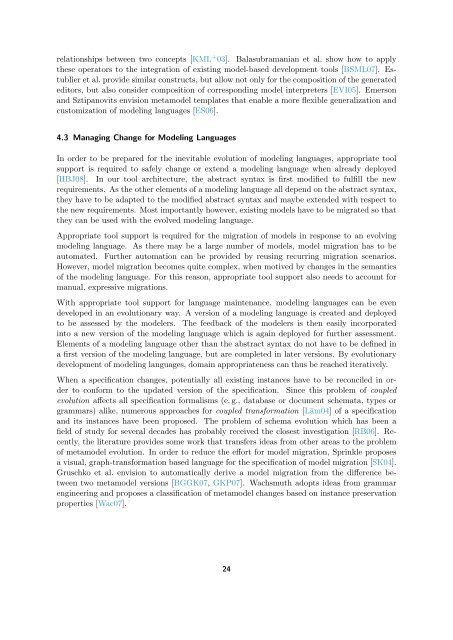SPES 2020 Deliverable 1.4.B-3 Concepts for an Integrated Tool ...
SPES 2020 Deliverable 1.4.B-3 Concepts for an Integrated Tool ...
SPES 2020 Deliverable 1.4.B-3 Concepts for an Integrated Tool ...
You also want an ePaper? Increase the reach of your titles
YUMPU automatically turns print PDFs into web optimized ePapers that Google loves.
elationships between two concepts [KML + 03]. Balasubram<strong>an</strong>i<strong>an</strong> et al. show how to apply<br />
these operators to the integration of existing model-based development tools [BSML07]. Estublier<br />
et al. provide similar constructs, but allow not only <strong>for</strong> the composition of the generated<br />
editors, but also consider composition of corresponding model interpreters [EVI05]. Emerson<br />
<strong>an</strong>d Sztip<strong>an</strong>ovits envision metamodel templates that enable a more flexible generalization <strong>an</strong>d<br />
customization of modeling l<strong>an</strong>guages [ES06].<br />
4.3 M<strong>an</strong>aging Ch<strong>an</strong>ge <strong>for</strong> Modeling L<strong>an</strong>guages<br />
In order to be prepared <strong>for</strong> the inevitable evolution of modeling l<strong>an</strong>guages, appropriate tool<br />
support is required to safely ch<strong>an</strong>ge or extend a modeling l<strong>an</strong>guage when already deployed<br />
[HBJ08]. In our tool architecture, the abstract syntax is first modified to fulfill the new<br />
requirements. As the other elements of a modeling l<strong>an</strong>guage all depend on the abstract syntax,<br />
they have to be adapted to the modified abstract syntax <strong>an</strong>d maybe extended with respect to<br />
the new requirements. Most import<strong>an</strong>tly however, existing models have to be migrated so that<br />
they c<strong>an</strong> be used with the evolved modeling l<strong>an</strong>guage.<br />
Appropriate tool support is required <strong>for</strong> the migration of models in response to <strong>an</strong> evolving<br />
modeling l<strong>an</strong>guage. As there may be a large number of models, model migration has to be<br />
automated. Further automation c<strong>an</strong> be provided by reusing recurring migration scenarios.<br />
However, model migration becomes quite complex, when motived by ch<strong>an</strong>ges in the sem<strong>an</strong>tics<br />
of the modeling l<strong>an</strong>guage. For this reason, appropriate tool support also needs to account <strong>for</strong><br />
m<strong>an</strong>ual, expressive migrations.<br />
With appropriate tool support <strong>for</strong> l<strong>an</strong>guage mainten<strong>an</strong>ce, modeling l<strong>an</strong>guages c<strong>an</strong> be even<br />
developed in <strong>an</strong> evolutionary way. A version of a modeling l<strong>an</strong>guage is created <strong>an</strong>d deployed<br />
to be assessed by the modelers. The feedback of the modelers is then easily incorporated<br />
into a new version of the modeling l<strong>an</strong>guage which is again deployed <strong>for</strong> further assessment.<br />
Elements of a modeling l<strong>an</strong>guage other th<strong>an</strong> the abstract syntax do not have to be defined in<br />
a first version of the modeling l<strong>an</strong>guage, but are completed in later versions. By evolutionary<br />
development of modeling l<strong>an</strong>guages, domain appropriateness c<strong>an</strong> thus be reached iteratively.<br />
When a specification ch<strong>an</strong>ges, potentially all existing inst<strong>an</strong>ces have to be reconciled in order<br />
to con<strong>for</strong>m to the updated version of the specification. Since this problem of coupled<br />
evolution affects all specification <strong>for</strong>malisms (e. g., database or document schemata, types or<br />
grammars) alike, numerous approaches <strong>for</strong> coupled tr<strong>an</strong>s<strong>for</strong>mation [Läm04] of a specification<br />
<strong>an</strong>d its inst<strong>an</strong>ces have been proposed. The problem of schema evolution which has been a<br />
field of study <strong>for</strong> several decades has probably received the closest investigation [RB06]. Recently,<br />
the literature provides some work that tr<strong>an</strong>sfers ideas from other areas to the problem<br />
of metamodel evolution. In order to reduce the ef<strong>for</strong>t <strong>for</strong> model migration, Sprinkle proposes<br />
a visual, graph-tr<strong>an</strong>s<strong>for</strong>mation based l<strong>an</strong>guage <strong>for</strong> the specification of model migration [SK04].<br />
Gruschko et al. envision to automatically derive a model migration from the difference between<br />
two metamodel versions [BGGK07, GKP07]. Wachsmuth adopts ideas from grammar<br />
engineering <strong>an</strong>d proposes a classification of metamodel ch<strong>an</strong>ges based on inst<strong>an</strong>ce preservation<br />
properties [Wac07].<br />
24
















